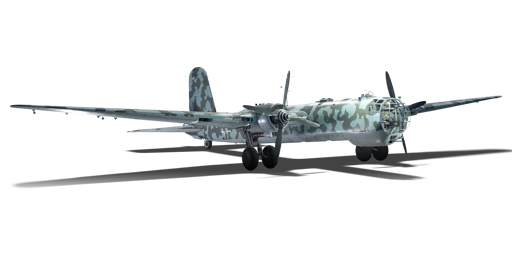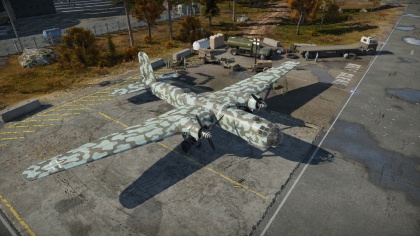He 177 A-5
Contents
Description
The He 177 A-5 Greif is a Rank IV German heavy bomber with a battle rating of 5.7 (AB/SB) and 5.3 (RB). It was introduced in Update 1.77 "Advancing Storm" as part of the revenue share program. It was created by Daniil "Joy_Division__ Zaytsev.
The Heinkel He 177 A-5 is a heavy bomber that excels at destroying stationary targets such as pillboxes and bases from altitude. His speed allows to bomb one base or two before confronting any enemy plane and then withdrawing back in shallow dive. Even if an enemy is trying to intercept you, your defensive armament in manual mode would keep it at bay.
General info
Flight Performance
| Characteristics | |||||||
|---|---|---|---|---|---|---|---|
| Stock | |||||||
| Max Speed (km/h at 6,500 m) |
Max altitude (meters) |
Turn time (seconds) |
Rate of climb (meters/second) |
Take-off run (meters) | |||
| AB | RB | AB | RB | AB | RB | ||
| ? | ? | 10,000 | ??.? | ??.? | ??.? | ??.? | 1,600 |
| Upgraded | |||||||
| Max Speed (km/h at 6,500 m) |
Max altitude (meters) | Turn time (seconds) | Rate of climb (meters/second) |
Take-off run (meters) | |||
| AB | RB | AB | RB | AB | RB | ||
| ? | ? | 10,000 | ??.? | ??.? | ?.? | ?.? | 1,600 |
Details
| Features | ||||
|---|---|---|---|---|
| Combat flap | Take-off flap | Landing flap | Air brakes | Arrestor gear |
| ✓ | ✓ | ✓ | X | X |
| Limits | ||||
|---|---|---|---|---|
| Wing-break speed (km/h) |
Gear limit (km/h) |
Combat flap (km/h) |
Max Static G | |
| + | - | |||
| ??? | ??? | ??? | ~?? | ~? |
| Optimal velocities | |||
|---|---|---|---|
| Ailerons (km/h) |
Rudder (km/h) |
Elevators (km/h) |
Radiator (km/h) |
| < ??? | < ??? | < ??? | > ??? |
| Compressor (RB/SB) | ||
|---|---|---|
| Setting 1 | ||
| Optimal altitude | 100% Engine power | WEP Engine power |
| ?,??? m | ??? hp | ?,??? hp |
Survivability and armour
- 9 mm Steel plates in pilot’s seat.
- 7 mm Steel plate under entire cockpit
- 9 mm Steel plate in front of front dorsal gunner.
- 7 mm Steel plates on cockpit roof around front dorsal gunner.
- 7 mm Steel plates around rear dorsal gunner.
- 7 mm Steel box in front of rear dorsal gunner.
- 57 mm Bulletproof glass in front of tail gunner.
- 9 mm Steel plates around the bottom and front of tail gunner.
Armaments
-->
Suspended armament
Describe the aircraft's suspended armament: additional cannons under the wings, bombs, rockets and torpedoes. This section is especially important for bombers and attackers. If there is no suspended weaponry remove this subsection.
The He 177 A-5 can be outfitted with the following ordinance:
- 48 x 50 kg SC50JA bombs (2,400 kg total)
- 12 x 250 kg SC250JA bombs (3,000 kg total)
- 6 x 500 kg SC500K bombs (3,000 kg total)
- 4 x 1,000 kg SC1000L2 bombs (4,000 kg total)
- 2 x 1,800 kg SC1800B bombs (2,700 kg total)
- 2 x 1,800 kg SC1800B bombs + 6 x 500 kg SC500K bombs (4,200 kg total)
- 3 x 1,400 kg PC 1400 X (Fritz X) bombs (4,200 kg total)
Defensive armament
Defensive armament with turret machine guns or cannons, crewed by gunners. Examine the number of gunners and what belts or drums are better to use. If defensive weaponry is not available remove this subsection.
The He 177 A-5 can defend itself with:
- 1 x 20 mm MG 151 cannon, chin turret (300 rpg)
- 1 x 20 mm MG 151 cannon, tail turret (800 rpg)
- 2 x 13 mm MG 131 machine gun, front dorsal turret (1,000 rpg = 2,000 rpg)
- 1 x 13 mm MG 131 machine gun, rear dorsal turret (1,000 rpg)
- 1 x 13 mm MG 131 machine gun, ventral turret (1,000 rpg)
- 1 x 7.92 mm MG 81 machine gun, nose turret (1,000 rpg)
Usage in the battles
Combining the speed and handling of the Do 217 and the immense payload of the Lancaster along with defensive armament approaching that of the American bombers, the He 177 Greif is an outstanding heavy bomber. Its max payload of 2 x 1,800 kg and 6 x 500 kg bombs is easily the best of its contemporaries when it comes to demolishing bases in AB and airfields in RB/SB. Other payloads are quite useful depending on the bombing objectives in RB/SB : 6 x 500 kg against bases (3 per bases), 4 x 1000 kg and 2 x 1800 kg for aircraft carriers and airfields.
The He 177 bears some similarities to the Do 217 series. It has an exceptionally high dive speed for a heavy bomber, and is capable of reaching up to 700 km/h in a dive. It is however more maneuverable at high speeds, one has to be careful not to overload the wings. The two engines (which are really two V12 DB 605 engines coupled together to drive one four-bladed propeller, making them essentially 24 cylinder engines) are very powerful, but at the same time more vulnerable to damage.
The defensive armament of the Greif is very good by German standards, consisting primarily of 13 mm MG 131 heavy machine guns, completed with 2 MG 151/20 cannons, one in front and one in tail turret. The large tail fin prevents the dorsal turrets from firing directly to the rear, leaving only the MG 151/20, however.
Manual Engine Control
| MEC elements | ||||||
|---|---|---|---|---|---|---|
| Mixer | Pitch | Radiator | Supercharger | Turbocharger | ||
| Oil | Water | Type | ||||
| Controllable | Not controllable | Not controllable | Not controllable | Separate | Not ontrollable | Not controllable |
Modules
| Tier | Flight performance | Survivability | Weaponry |
|---|---|---|---|
| I | Fuselage Repair, Radiator | ||
| II | Compressor | Airframe | |
| III | Wing Repair, Engines | ||
| IV | Engine Injection | Cover |
Pros and cons
Pros:
- Heavy defensive weaponry
- Plenty of bomb load options
- Large bomb bay: can house four 1,000 kg bombs
- One of only three heavy bombers for Germany, and the only high rank heavy bomber in the tech tree
- Capable of speeds of up to 530 km/h or 340 mph in level flight
- Good climb rate
- Dual engine aerodynamic, make it quite manoevrable for a heavy bomber
Cons:
- Plane is vulnerable in frontal engagement due to absence of copilot and the glazed nose
- Engines overheat very quickly when activating WEP rate
- Landing gear takes a long time to deploy and retract
- Engines overheat quickly when cooling system is empty
- Vulnerable on the sides
- No airbrakes
History
Describe the history of the creation and combat usage of the aircraft in more detail than in the introduction. If the historical reference turns out to be too big, take it to a separate article, taking a link to an article about the vehicle and adding a block "/ historical reference" (example: https://wiki.warthunder.com/Name-vehicles/historical reference) and add a link to it here using the main template. Be sure to include links to sources at the end of the article.
Media
An excellent addition to the article will be video guides, as well as screenshots from the game and photos.
Read also
Links to the articles on the War Thunder Wiki that you think will be useful for the reader, for example,
- reference to the series of the aircraft;
- links to approximate analogues of other nations and research trees.
Sources
Paste links to sources and external resources, such as:
- topic on the official game forum;
- page on aircraft encyclopedia;
- other literature.
| Germany bombers | |
|---|---|
| Arado | Ar 196 A-3 |
| Blohm & Voss | BV 138 C-1 · BV 238 |
| Dornier | Do 17 E-1 · Do 17 Z-2 · Do 217 E-2 · Do 217 E-4 · Do 217 K-1 · Do 217 M-1 |
| Focke-Wulf | Fw 189 A-1 · Fw 200 C-1 |
| Henschel | Hs 123 A-1 |
| Heinkel | He 111 H-3 · He 111 H-6 · He 111 H-16 · He 115 C-1 · He 177 A-3 · He 177 A-5 |
| Junkers | Ju 87 B-2 · Ju 87 R-2 · Ju 87 R-2 Libya · Ju 87 D-3 · Ju 87 D-5 · Ju 88 A-1 · Ju 88 A-4 · Ju 188 A-2 · Ju 288 C |
| Messerschmitt | Me 264 |
| Savoia-Marchetti | ▀S.M.79 serie 1 · ▀S.M.79 B · ▀S.M.79 serie 4 · ▀S.M.79 serie 8 |
| ▀S.M.79 AS · ▀S.M.79 bis/N · ▀S.M.79 bis/T.M | |
| Trophies | ▀Wellington Mk Ic |





